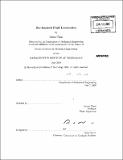Bio-inspired fluid locomotion
Author(s)
Chan, Brian, 1980-
DownloadFull printable version (64.06Mb)
Other Contributors
Massachusetts Institute of Technology. Dept. of Mechanical Engineering.
Advisor
Anette Hosoi.
Terms of use
Metadata
Show full item recordAbstract
We have developed several novel methods of locomotion at low Reynolds number, for both Newtonian and non-Newtonian fluids: Robosnails 1 and 2, which operate on a lubrication layer, and the three-link swimmer which moves in an unbounded fluid. Robosnail 1 utilizes lubrication pressures generated in a Newtonian fluid under a steadily undulating foot to propel itself forward. Tractoring force and velocity measurements are in agreement with analytic and numerical solutions. Robosnail 2, modeled after real land snails, uses in-plane compressions of a flat foot on a mucus substitute such as Laponite or Carbopol. Robosnail 2 exploits the non-Newtonian qualities (yield-stress, shear thinning) of the fluid solution to locomote. The glue-like behavior of the unyielded fluid allows Robosnail 2 to climb up a 90 degree incline or inverted 180 degree surfaces. The three-link swimmer is a device composed of three rigid links interconnected by two out-of-phase oscillating joints. It is the first experimental test that successfully demonstrates that a swimmer of its kind can translate in the Stokes limit.
Description
Thesis (Ph. D.)--Massachusetts Institute of Technology, Dept. of Mechanical Engineering, 2009. Includes bibliographical references (leaves 95-99).
Date issued
2009Department
Massachusetts Institute of Technology. Department of Mechanical EngineeringPublisher
Massachusetts Institute of Technology
Keywords
Mechanical Engineering.